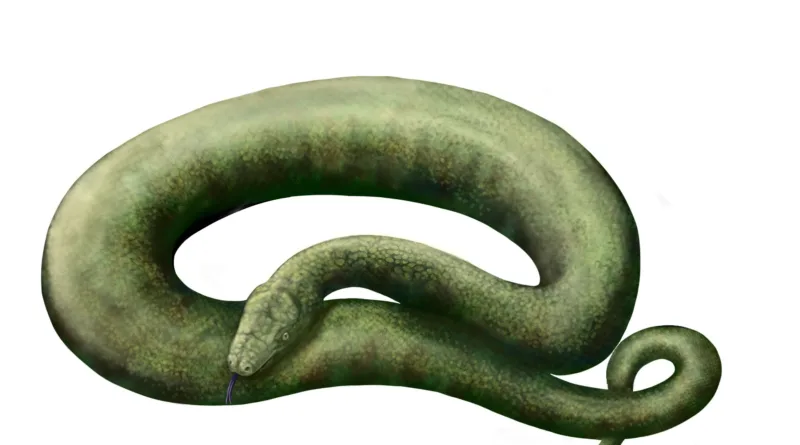Where Does Vasuki Indicus:The Giant Snake of India Come From?
The Discovery of Vasuki Indicus
The discovery of Vasuki Indicus, a remarkable titan among ancient serpents, took place within the geologically rich Kutch Basin of India. In the early 21st century, a team of paleontologists initiated excavations in this region, known for its diverse fossil beds. The Kutch Basin’s unique geological characteristics, including sedimentary rock layers, provided an optimal environment for the preservation of organic materials over millions of years. This led researchers to hypothesize the presence of significant fossils within its strata.
During systematic fieldwork, the scientists employed various techniques, such as stratigraphic analysis and radiometric dating, to assess the age of the discovered fossils. Initial clues that hinted at the existence of Vasuki Indicus emerged when fragments of large vertebrae and distinctive skull features were unearthed. The size of the remains indicated that this species was likely one of the largest known snakes, igniting excitement and anticipation among the scientific community.
The role of the paleontologists involved in the excavation cannot be overstated. Their expertise in identifying and interpreting fossilized remains has greatly advanced our understanding of prehistoric life. Collaborative efforts from various institutions facilitated a multidisciplinary approach, allowing specialists from geology, biology, and anthropology to study the find thoroughly. This interconnection of scientific disciplines greatly enhances the relevance of the Vasuki Indicus discovery, underscoring its importance not merely as a singular find but as a part of the broader paleontological narrative.
Furthermore, the environmental conditions of the Kutch Basin, characterized by arid climates and episodic flooding, contributed to the effective preservation of fossils. As sediment layers accumulated, they shielded the remains and minimized exposure to destructive elements, resulting in exceptional fossilization. This discovery of Vasuki Indicus offers valuable insights into evolutionary biology and the ecological dynamics of ancient ecosystems, enriching our grasp of the serpentine lineage and its historical context.
Anatomy and Characteristics of Vasuki Indicus
The Vasuki Indicus, an extraordinary specimen from India’s prehistoric era, is known for its impressively massive anatomy. This giant snake could reach astonishing lengths of up to 50 feet, making it one of the largest snakes recorded in history. With a weight nearing 2,200 pounds, its size presents not only a magnificent sight but also considerable implications for its ecological role and predatory behavior. The anatomy of Vasuki Indicus provides essential insight into the evolutionary adaptations that allowed such a creature to thrive in its environment.
One of the most striking physical features of this prehistoric reptile is its broad, cylindrical body shape. This morphology not only contributed to its size but also enhanced its ability to navigate through various terrains and hunt effectively. Its robust vertebral column, specially adapted to support its immense weight, facilitated powerful movements that would be integral for capturing and constraining prey. Unlike modern snakes, such as pythons, which are also large and muscular, the vertebral anatomy of Vasuki Indicus may indicate different locomotion patterns and hunting strategies due to its sheer size.
The comparative analysis between the Vasuki Indicus and contemporary pythons illustrates divergent evolutionary paths. While both share common ancestors, the adaptations in the Vasuki Indicus’s structure suggest a lifestyle that might have involved ambush hunting in large prehistoric ecosystems. Its formidable girth and length would have enabled it to subdue substantial prey, confirming its status as a top predator of its time. Understanding the anatomical and characteristic traits of Vasuki Indicus not only enriches our knowledge of this colossal snake but also aids in comprehending the ecological dynamics of its prehistoric habitat.
Habitat and Behavior of the Prehistoric Predator
The habitat of Vasuki Indicus during the Eocene epoch, approximately 34 to 56 million years ago, was shaped by a warm and humid climate that prevailed across the Indian subcontinent. This period was characterized by dense tropical forests, abundant vegetation, and a myriad of water bodies, creating a rich and diverse ecosystem. The overall climatic conditions allowed for a flourishing habitat that could support various life forms, including Vasuki Indicus, a large and formidable predator. Fossil evidence suggests that the regions inhabited by this giant snake included river valleys and floodplains, which provided a suitable environment for hunting and reproduction.
Vasuki Indicus, like modern pythons, exhibited remarkable ambush tactics that were critical for its survival in such an environment. Its slender, elongated body would have favored stealthy movements through dense foliage, allowing it to conceal itself while waiting for prey. As a carnivorous reptile, Vasuki Indicus primarily preyed on smaller mammals and birds, capitalizing on its ability to strike swiftly with precision. The predatory behavior of this ancient snake can be compared to that of contemporary large constrictors, which also rely on surprise and force to subdue their prey. Analyzing its habits provides valuable insight into the ecological dynamics of the time.
The prevalence of numerous species within its habitat likely led to competition, requiring Vasuki Indicus to adapt its hunting strategies. The presence of large herbivores and a variety of fauna implied that it had to exert considerable effort in securing food sources. Furthermore, the snake’s ability to control its body temperature through basking in the sun would have enhanced its hunting prowess, making it a crucial predator in the Eocene ecosystem. Overall, the habitat and behavior of Vasuki Indicus reflect a well-adapted predator, vital to understanding prehistoric ecological systems.
The Significance of Vasuki Indicus in India’s Paleontological History
The discovery of Vasuki Indicus holds substantial significance within the realm of India’s paleontological history. This remarkable giant snake, which roamed the Earth during the prehistoric era, is a crucial nexus for understanding the evolutionary lineage of snakes. Its fossils offer invaluable insights into the morphological and ecological adaptations that have occurred over millions of years. As a member of the colubroid family hypothetically linked to modern serpents, Vasuki Indicus exemplifies the fascinating transition of snakes from their ancestral forms to the diverse species we see today.
Vasuki Indicus also contributes to a richer understanding of the biodiversity that characterized the Indian subcontinent during prehistoric times. The snake’s remains, uncovered in various parts of India, highlight the complex ecosystems that once thrived, including a variety of reptiles, mammals, and flora. Such discoveries align with current efforts to reconstruct ancient habitats and assess how climate changes influenced species evolution and extinction. The implications of this giant snake extend beyond mere fossil records; they stimulate discussions on biogeography and the ecological dynamics that shaped life in India.
In addition, the significance of Vasuki Indicus extends into the realm of scientific research and education. This formidable snake’s fossils have become focal points for paleontology programs across universities and research institutions in India. By engaging students and researchers with tangible evidence from the past, these findings foster a deeper appreciation for the science of paleontology. Moreover, they ignite interest in conservation efforts linked to protecting biodiversity based on historical knowledge. Understanding the legacy of such remarkable species underscores the critical need for ongoing paleontological study, ensuring that knowledge continues to evolve and inspire future generations.

